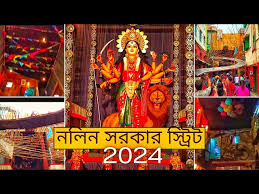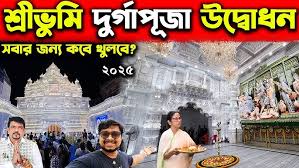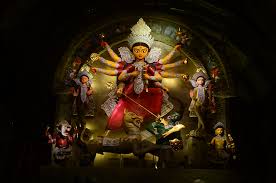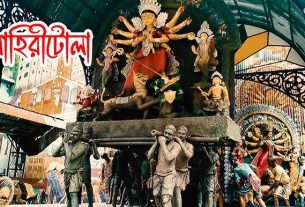In the heart of North Kolkata lies Nalin Sarkar Street, a location known for its evocative, socially resonant Durga Puja celebrations. In 2024, the Nalin Sarkar Street Sarbojanin Durga Puja introduced the compelling theme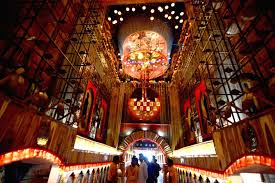 “Saharnama”—a poetic tribute to the stories of the city, its heartbeat, its people, and its paradoxes. This 2,500‑word exploration dives deep into how the pandal, the idol, the craft, and community engagement converged to create a festival that spoke to the soul of the urban experience.
“Saharnama”—a poetic tribute to the stories of the city, its heartbeat, its people, and its paradoxes. This 2,500‑word exploration dives deep into how the pandal, the idol, the craft, and community engagement converged to create a festival that spoke to the soul of the urban experience.
Legacy & Cultural Resonance
Nalin Sarkar Street Durga Puja, steeped in decades of tradition (est. 1933), has continuously evolved by adopting bold, meaningful themes. Previous narratives—like the 2023 “Sambhabona” (Possibility) or earlier commentaries on mental health, addiction, and environmental interdependence—made the puja a touchstone of cultural consciousness.
Saharnama builds upon this tradition, capturing the soul of urban life—its aspirations, conflicts, resilience, and everyday magic. Here, the pandal tells stories of concrete, rooftops, crowded lanes, and hidden dreams.
Decoding “Saharnama”: A Tale of the City
“Saharnama” translates to “Story of the City.” It is an ode to the city’s soul—the tangled architecture, the pulse of 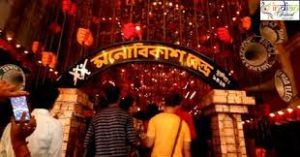 neon, the impulse of progress, the solitude of millions, and the dreams etched into each brick.
neon, the impulse of progress, the solitude of millions, and the dreams etched into each brick.
This theme embraces duality: vibrant with opportunity yet marked by alienation. The pandal becomes a microcosm of the metropolis—crowded yet solitary, tumultuous yet surprisingly tender.
The Pandal: Urban Landscape in Art
Crafting a physical narrative in a narrow lane, the designers gave form to urban experience:
-
Compact brilliance: Using architectural motifs—mini skyscraper facades, colonial-era arches, street signs—the pandal compressed the city’s sprawl into a single immersive walk-through.
-
Texture & materiality: Corrugated metal sheets, afternoon-worn bricks, posters peeling with age, and dangling cables evoked familiar visuals from Kolkata’s skyline.
-
Interactive elements: Light installations mimicked moving vehicles or billboards. A layer of sound—horns, murmurs, chaiwala callouts—made the city audible.
-
Contrast of old and new: Colonial pillars alongside graffiti-marked walls. A tree growing through concrete. Signboards for long-forgotten businesses.
This wasn’t mere decoration; it was an urban poem in three dimensions.
The Idol: Durga as Protector of the Metropolis
Within this urban swirl stood the evocative idol:
-
Symbolic attire: Goddess Durga was swathed in textures resembling familiar city materials—brick-red clay sari, steel-toned jewelry echoing signboards.
-
Pose & expression: She stood poised with strength and quiet vigilance, embodying the city’s protective spirit amid chaos.
-
Accompaniment: Her lion companion carried motifs of both ancient courage and modern grit.
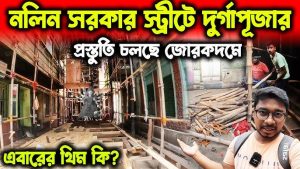
-
Absence of fantasy: There was no demon beneath her feet. Instead, Durga faced us as protector of the real world—of lanes, rooftops, and dreams.
The idol connected divinity not with myth alone but with lived urban experience.
Cultural Invitations: Programming That Speaks City
Festivities went beyond rituals:
-
Street theatre: Scenes depicting daily lives of city workers—vendors, tram conductors, domestic helpers—interplayed with dancers reenacting Kolkata idioms.
-
Folk music meets Metro jingles: Rabindra Sangeet and Baul songs intertwined with modern compositions reflecting city’s pace and nostalgia.
-
Photography exhibits: Candid frames of city life—rickshaw pullers, street vendors, rush-hour crowds—displayed along exhibition stalls.
-
Interactive installations: Visitors were invited to paste their handwritten “city stories” on a communal collage wall.
This turned the puja into a participatory narrative experience.
Inclusion & Accessibility: A City for All
Reflecting the city’s diversity, the puja prioritized accessibility:
-
Wheelchair-ready pathways, benches for the elderly, priority access.
-
Engaged slum children, migrant workers, persons with disabilities in cultural and logistical roles.
-
Social outreach: Medical camps, food and garment donations, and workshops for underprivileged local households.
These efforts ensured the festival’s inclusivity radiated beyond artistic expression into action.
Eco-Design: Sustainability Woven into Urban Narrative
“Saharnama” wasn’t just about urban themes—it also built responsibly:
-
Materials used were recycled: abandoned signboards, cloth, wood panels from construction, repurposed metal.
-
Lighting adapted to energy-saving LEDs, and painting used non-toxic organic colors.
-
Post-festival, the plan included dismantling and reusing the materials for community art projects.
This reinforced the narrative: A city can evolve sustainably without erasing its history.
Community’s Pulse: Authentic Urban Emotion
The heartbeat of any puja is its people:
-
Residents of Nalin Sarkar Street—young and old—formed a volunteer brigade: managing crowds, guiding visitors, reciting stories.
-
Artisans were primarily local, preserving crafts, idioms, and memories unique to the neighborhood.
-
Emotional authenticity: Visitors documented tearful parents recounting childhood memories, young couples posing in front of nostalgia-rich murals, schoolchildren reading out city tales.
These moments added authentic texture to the theme.
Reflections: Why “Saharnama” Mattered
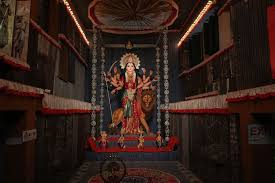 In an age of dazzling spectacle, “Saharnama” stood apart for its thematic maturity and civic insight. It was not just a pandal—it was a storyteller, a citizen philosopher, and a canvas for urban poetry. It prioritized emotional heritage over visual noise, realism over fantasy, people over panels.
In an age of dazzling spectacle, “Saharnama” stood apart for its thematic maturity and civic insight. It was not just a pandal—it was a storyteller, a citizen philosopher, and a canvas for urban poetry. It prioritized emotional heritage over visual noise, realism over fantasy, people over panels.
Nalin Sarkar Street’s 2024 puja showed that a Durga Puja can be a festival of cultural introspection, collective identity, and civic responsibility—a narrative as rich as the city it reflected.
Visiting Guide: Experience “Saharnama” Fully
-
Timing: Early morning (dawn–9 am) for serene immersion. Evenings (7–10 pm) for light interplay and performances.
-
Accessibility: Chairs, wheel access, restroom facilities are available.
-
Engagement: Attend cultural programs. Share your “city story” at the collage wall.
-
Support local: Browse craft stalls, help modest vendors.
-
Reflect: Sit quietly inside, let the narrative sink in—see the city in a new light.
Final Echoes: City, Soul, Festival
Nalin Sarkar Street Sarbojanin Durga Puja 2024—through Saharnama—articulated the city’s myriad emotions: its construction and cracks, conviviality and conflict, memory and motion. It was an urban elegy, a cultural dialogue, and a communal prayer all in one.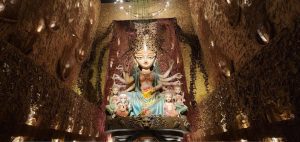
As dhak beats fade and the idol submerges, the story remains. A story of the city—and of us, alive within it, carrying its stories forward.
Let this blog be your tribute to Saharnama, a soul-stirring urban tapestry woven in clay, light, and shared hearts by Nalin Sarkar Street in 2024.

